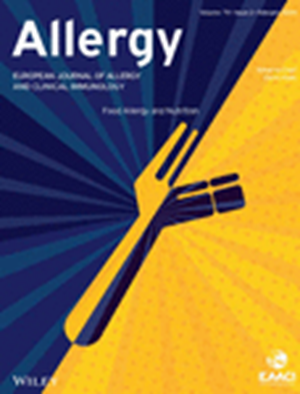鼻腔微生物组及其与环境暴露和呼吸健康的关系。
IF 12
1区 医学
Q1 ALLERGY
引用次数: 0
摘要
鼻腔微生物群与外界环境直接接触,可能在呼吸系统健康中发挥作用。本研究旨在评估青少年鼻腔微生物群与空气污染物、气象条件和呼吸健康的关系。方法我们分析了来自Viva项目队列的416名青少年(平均年龄13岁,52%为女性)的鼻腔微生物组。我们通过校正混杂因素并使用错误发现率(FDR) < 5%进行校正的回归模型,测试了α多样性、鼻型和细菌属丰度与过去2天至过去一年的环境暴露(PM2.5、NO2、O3、温度、湿度、住宅绿化)和呼吸结果(哮喘、花粉热、喘息、IgE、气致过敏原致敏、FeNO、肺功能)之间的关联。结果细菌多样性与花粉热和短期暴露于NO2呈正相关,与温度呈负相关(FDR < 0.05)。以莫拉菌为主的青少年在过去一周内暴露于较低的O3水平(ORs: 0.73-0.76)和较高的温度和湿度(ORs: 1.19-1.26)。葡萄球菌优势与丙酸杆菌优势正相关(OR: 4.48, FDR = 0.03)。13和8个细菌属丰度与中短期暴露(PM2.5、NO2、温度)和呼吸结果(花粉热、喘息、IgE、FeNO、肺功能)相关(FDR < 0.05)。葡萄球菌、杆状杆菌、Pelomonas、乳球菌、毛螺杆菌科(未分类)和粪杆菌的丰度与环境暴露和呼吸特征有关。结论鼻腔微生物群多样性与花粉热、二氧化氮和温度暴露有关。多次中短期环境暴露和呼吸结果与青少年的鼻型和细菌属丰度有关。本文章由计算机程序翻译,如有差异,请以英文原文为准。
The Nasal Microbiome and Associations With Environmental Exposures and Respiratory Health.
BACKGROUND
The nasal microbiome is directly in contact with the external environment and may play a role in respiratory health. This study aimed to evaluate the association of the nasal microbiome with air pollutants, meteorological conditions, and respiratory health in adolescents.
METHODS
We analyzed the nasal microbiome in 416 adolescents from the Project Viva cohort (mean age 13 years and 52% female). We tested for the association of alpha diversity, nasotypes, and bacterial genera abundance with environmental exposures from the past 2 days to the past year (PM2.5, NO2, O3, temperature, humidity, residential greenness) and respiratory outcomes (asthma, hay fever, wheezing, IgE, aeroallergen sensitization, FeNO, lung function) through regression models adjusted for confounders and corrected using a false discovery rate (FDR) < 5%.
RESULTS
Bacterial diversity was positively associated with hay fever and short-term exposure to NO2, while it was negatively correlated with temperature (FDR < 0.05). Adolescents whose nasal microbiome was dominated by Moraxella were exposed in the past week to lower O3 levels (ORs: 0.73-0.76) and higher temperature and humidity (ORs: 1.19-1.26). Staphylococcus dominance was positively associated with aeroallergen sensitization compared to Propionibacterium dominance (OR: 4.48, FDR = 0.03). Thirteen and eight bacterial genera abundance were associated with short-to-medium-term exposures (PM2.5, NO2, temperature) and respiratory outcomes (hay fever, wheezing, IgE, FeNO, lung function) (FDR < 0.05). Staphylococcus, Corynebacterium, Pelomonas, Lactococcus, Lachnospiraceae (unclassified), and Faecalibacterium abundance were associated with both environmental exposures and respiratory traits.
CONCLUSIONS
Nasal microbiome diversity was associated with hay fever, NO2, and temperature exposure. Multiple short-to-medium-term environmental exposures and respiratory outcomes were associated with nasotypes and bacterial genera abundance in adolescents.
求助全文
通过发布文献求助,成功后即可免费获取论文全文。
去求助
来源期刊

Allergy
医学-过敏
CiteScore
26.10
自引率
9.70%
发文量
393
审稿时长
2 months
期刊介绍:
Allergy is an international and multidisciplinary journal that aims to advance, impact, and communicate all aspects of the discipline of Allergy/Immunology. It publishes original articles, reviews, position papers, guidelines, editorials, news and commentaries, letters to the editors, and correspondences. The journal accepts articles based on their scientific merit and quality.
Allergy seeks to maintain contact between basic and clinical Allergy/Immunology and encourages contributions from contributors and readers from all countries. In addition to its publication, Allergy also provides abstracting and indexing information. Some of the databases that include Allergy abstracts are Abstracts on Hygiene & Communicable Disease, Academic Search Alumni Edition, AgBiotech News & Information, AGRICOLA Database, Biological Abstracts, PubMed Dietary Supplement Subset, and Global Health, among others.
 求助内容:
求助内容: 应助结果提醒方式:
应助结果提醒方式:


